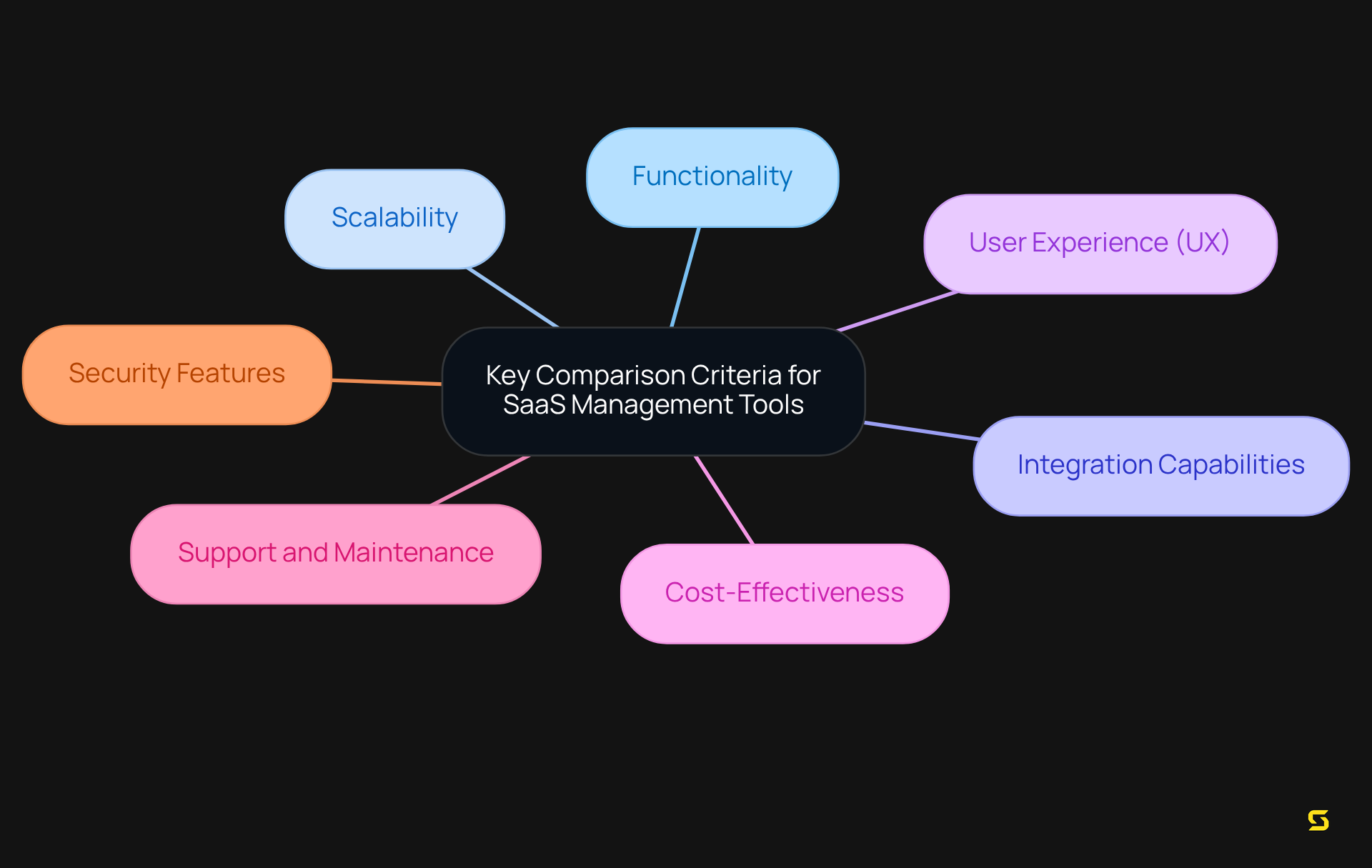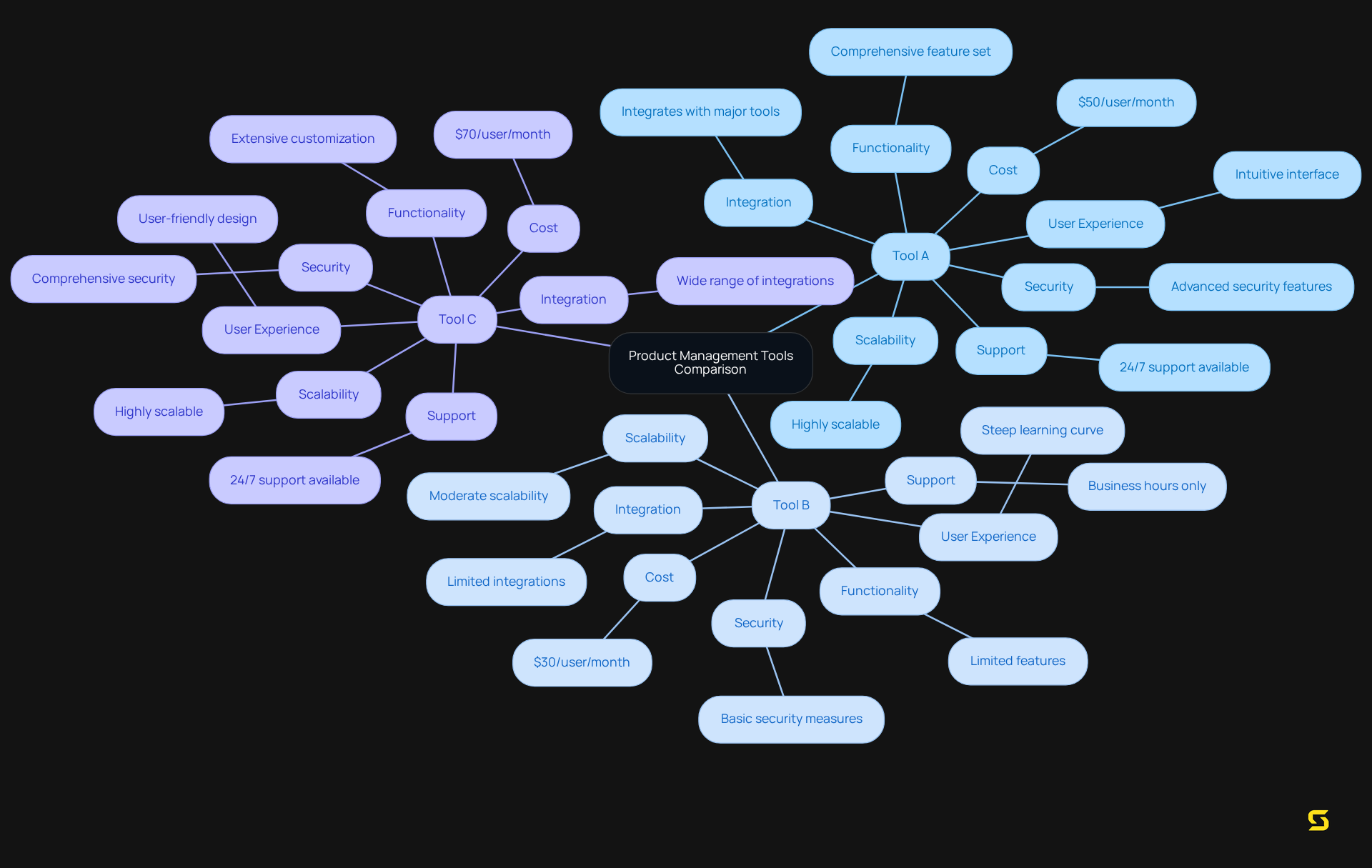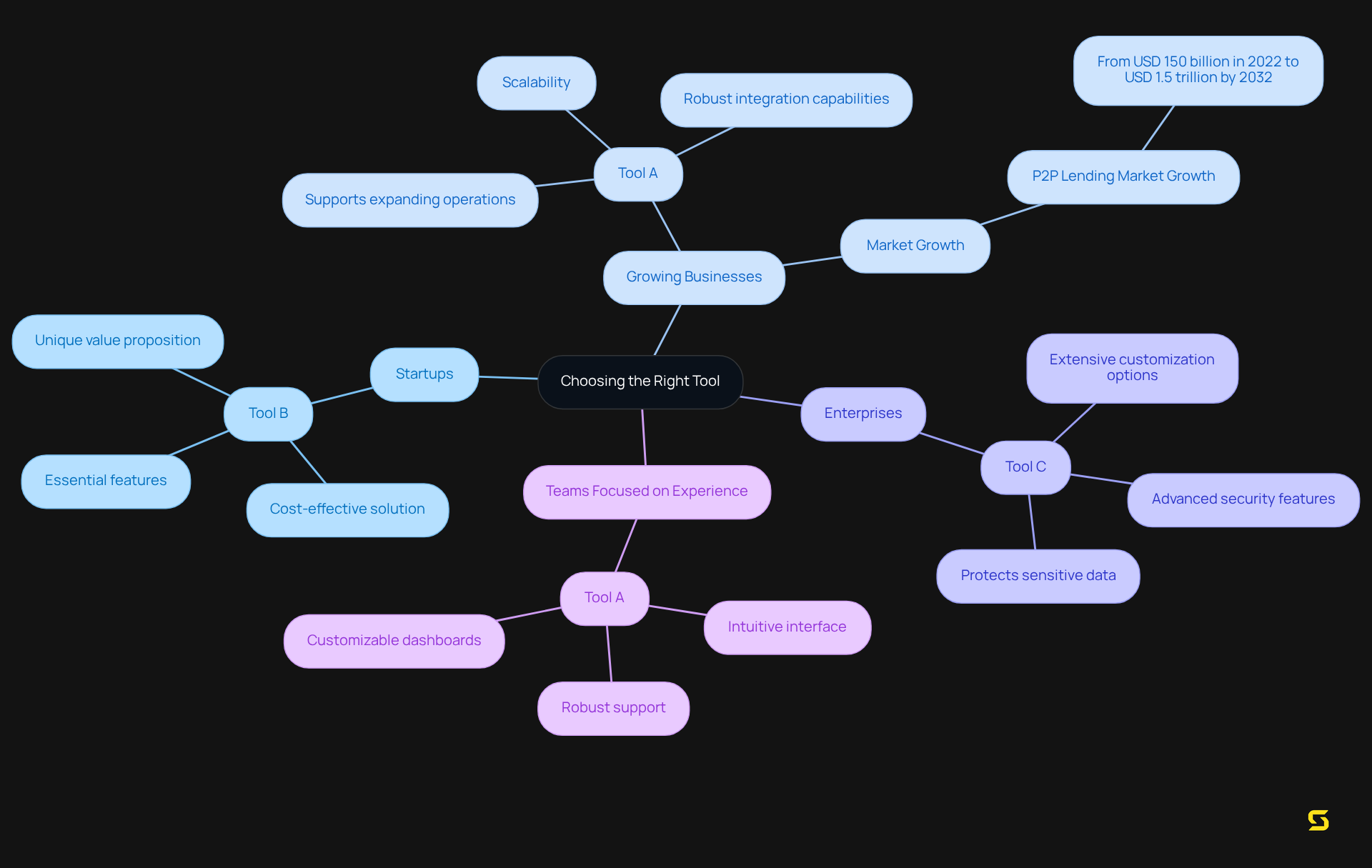Overview
The essential software and app selection criteria for SaaS management encompass:
- Functionality
- Scalability
- User experience
- Integration capabilities
- Cost-effectiveness
- Support
- Security features
These criteria are not merely suggestions; they are critical for organizations aiming to make informed decisions that significantly enhance operational efficiency and customer satisfaction. Poor selection can lead to inefficiencies and increased costs, a risk no organization can afford. By prioritizing these criteria, businesses position themselves to thrive in a competitive landscape.
Introduction
Selecting the right software for SaaS product management is a pivotal decision that can significantly influence an organization's efficiency and customer satisfaction. In an era where businesses increasingly rely on cloud-based solutions, understanding the essential criteria for software selection is not just important; it is paramount. This article explores the key factors organizations must consider—such as:
- Functionality
- Scalability
- User experience
While also addressing the challenges posed by a crowded marketplace. How can companies navigate these complexities to ensure they choose a tool that not only meets their immediate needs but also positions them for future growth?
Understanding the Importance of Software Selection for SaaS Product Management
Selecting the right software and app for SaaS product management is essential for organizations aiming to streamline operations and enhance customer experiences. The chosen application must not only meet the functional requirements of the business but also align with strategic objectives, ensuring effective resource utilization. Poor system selection can lead to inefficiencies, increased costs, and ultimately, a negative impact on user satisfaction. Therefore, understanding the criteria for is vital for any company aiming to thrive in a competitive landscape.
This section will explore the key elements that make application selection a critical component of cloud service management, including:
- Functionality
- Scalability
- User experience
Research shows that reliance on software and app solutions is on the rise, underscoring the necessity for organizations to prioritize informed software decisions. Key considerations include:
- Functionality
- Scalability
- User experience
These factors significantly affect overall satisfaction and performance. Notably, experience variables such as utility, usability, and aesthetics have been proven to profoundly influence customer satisfaction, with value being the most critical component. As Steve Jobs aptly stated, "Focus means saying no to the hundred other good ideas," illustrating the importance of prioritizing the right software solutions. By emphasizing these criteria, companies can enhance user engagement and drive improved business outcomes, ultimately positioning themselves for success in the evolving landscape of software and app.

Key Comparison Criteria for SaaS Management Tools
When evaluating SaaS management tools, organizations must consider several critical criteria to ensure they select the most suitable option. These criteria encompass:
- Functionality: The application must fulfill all essential functions required by the organization, ensuring it can efficiently handle specific tasks.
- Scalability: As businesses grow, their application needs may evolve. A scalable solution can adjust to increased demands without sacrificing performance.
- Integration Capabilities: The capacity to integrate with existing systems and tools is vital for seamless operations and data flow.
- User Experience (UX): A user-friendly interface enhances adoption rates and reduces training time, facilitating easier utilization of the application by teams.
- Cost-Effectiveness: Organizations should assess the total cost of ownership, encompassing subscription fees, maintenance costs, and potential hidden expenses.
- Support and Maintenance: Dependable customer support and regular updates are crucial for addressing issues and ensuring the software remains functional and secure.
- Security Features: Given the sensitive nature of data managed by software-as-a-service applications, robust security measures are indispensable.
These standards serve as a framework for entities to evaluate and compare various software management tools, ensuring they choose a solution that meets their specific requirements.

In-Depth Comparison of Leading SaaS Product Management Tools
In this section, we will compare three prominent software and app product management tools: Tool A, Tool B, and Tool C. Each software and app will be assessed based on essential comparison criteria identified earlier, including functionality, scalability, integration, user experience, cost, support, and security—vital factors for evaluating such tools.
-
Criteria
-
Tool A
-
Tool B
-
Tool C
-
Functionality
- Comprehensive feature set
- Limited features
- Extensive customization
-
Scalability
- Highly scalable
- Moderate scalability
- Highly scalable
-
Integration
- Integrates with major tools
- Limited integrations
- Wide range of integrations
-
User Experience
- Intuitive interface
- Steep learning curve
- User-friendly design
-
Cost
- $50/user/month
- $30/user/month
- $70/user/month
-
Support
- 24/7 support available
- Business hours only
- 24/7 support available
-
Security
- Advanced security features
- Basic security measures
- Comprehensive security
This comparison highlights the of each tool, empowering organizations to determine which solution aligns best with their operational needs and budget constraints. Furthermore, incorporating feedback from clients and expert evaluations can provide valuable insights into the performance and reliability of these tools, further assisting Product Owners in their decision-making process.

Choosing the Right Tool: Recommendations Based on User Needs
Selecting the appropriate software and app management tool is a strategic decision that depends on the specific needs and conditions of your organization. Tailored recommendations based on common user scenarios are as follows:
- For Startups: Startups seeking cost-effective solutions with essential features will find Tool B to be the optimal choice, thanks to its lower cost and adequate functionality. Establishing a unique value proposition is critical for startups aiming to differentiate themselves in a competitive market.
- For Growing Businesses: Organizations experiencing rapid growth should prioritize Tool A, which offers scalability and robust integration capabilities essential for supporting expanding operations. The financial sector is projected for significant growth, with the Global Peer to Peer (P2P) Lending Market expected to surge from USD 150 billion in 2022 to USD 1.5 trillion by 2032. This trend underscores the increasing demand for scalable SaaS solutions.
- For Enterprises: Large enterprises with complex needs can greatly benefit from Tool C, which provides extensive customization options and advanced security features designed to protect sensitive data. Security is a paramount concern for companies, especially in financial applications, to ensure client trust and compliance.
- For Teams Focused on Experience: For organizations where adoption and ease of use are priorities, Tool A is highly recommended due to its intuitive interface and robust support. The integration of can significantly enhance the user experience, enabling teams to tailor their interactions with the software and app.
By aligning the selection of SaaS management tools with specific user needs, companies can significantly enhance their operational efficiency and drive superior outcomes. This strategic approach not only addresses immediate requirements but also positions organizations for sustained success.

Conclusion
Selecting the appropriate software and applications for SaaS management is not just important; it is essential for organizations aiming to optimize their operations and elevate customer satisfaction. The effectiveness of these tools relies not only on their functionality and scalability but also on their alignment with the strategic goals of the business. By understanding and prioritizing the right selection criteria, companies can sidestep inefficiencies and ensure that their software solutions enhance user experiences and overall performance.
This article explores several critical factors that influence the selection of SaaS management tools:
- Functionality
- Scalability
- Integration capabilities
- User experience
- Cost-effectiveness
- Support
- Security features
Each criterion significantly impacts how well a tool meets an organization’s needs, ultimately shaping its operational efficiency and user satisfaction. A comparative analysis of various tools offers valuable insights, empowering organizations to make informed decisions tailored to their unique requirements.
In a landscape where software choices can determine a business's success, it is imperative for organizations to approach software selection with diligence and strategic foresight. By leveraging the insights shared in this article, companies can refine their SaaS management strategies, ensuring they select tools that not only meet current needs but also facilitate future growth. Embracing a thoughtful selection process will enable organizations to thrive in an increasingly competitive environment, driving both operational excellence and customer satisfaction.
Frequently Asked Questions
Why is software selection important for SaaS product management?
Software selection is crucial for SaaS product management as it helps organizations streamline operations, enhance customer experiences, and ensure effective resource utilization. Poor system selection can lead to inefficiencies, increased costs, and negatively impact user satisfaction.
What are the key criteria for selecting software for SaaS product management?
The key criteria for selecting software include functionality, scalability, and user experience. These factors significantly affect overall satisfaction and performance.
How does functionality impact software selection?
Functionality refers to how well the software meets the specific needs and requirements of the business, which is essential for effective SaaS product management.
Why is scalability an important consideration in software selection?
Scalability is important because it determines the software's ability to grow and adapt to the changing needs of the organization, ensuring that it can handle increased workloads and user demands over time.
How does user experience influence software selection?
User experience, including utility, usability, and aesthetics, profoundly influences customer satisfaction. A positive user experience can enhance engagement and drive better business outcomes.
What is the significance of value in software selection?
Value is considered the most critical component in software selection, as it encompasses the overall benefits and effectiveness of the software in meeting the organization's goals.
What does Steve Jobs' quote about focus imply in the context of software selection?
Steve Jobs' quote highlights the importance of prioritizing the right software solutions by emphasizing that organizations must be selective and strategic in their choices, avoiding distractions from less critical options.





